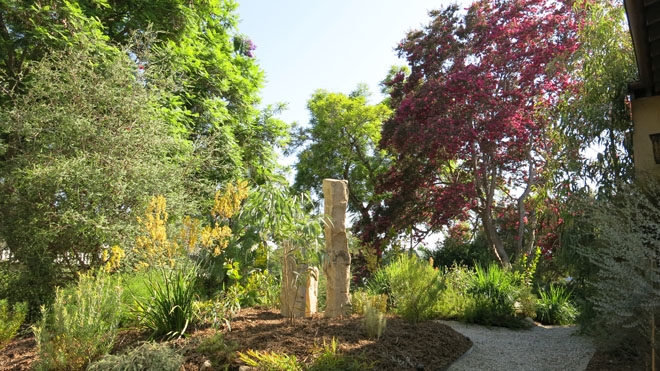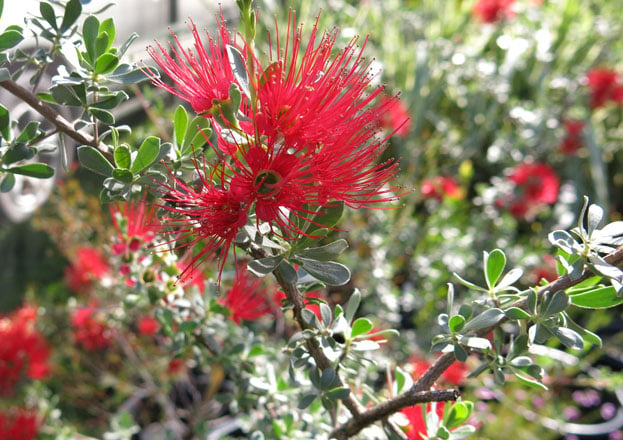

Contributor
- Topics: Archive, Inspired Gardens & Design

Sailing across the extensive blue waters of the South Pacific with my family as a child informs my garden today. During our voyage, my mother allowed me to choose a course of study. I chose to study plants, and I spent my time observing their biology, illustrating their forms, and writing about their economic and ethnobotanical uses in newsletters mailed home from each port. I received a liberal arts education in the truest sense: fine art, applied design, education, ecology, land and water management, and writing.
I completed my garden renovation in San Marino in 2011 in order to close the building permit for a 1926 Spanish house remodel on a plot of land measuring 57 by 119 feet. My early studies helped me plot an interdisciplinary garden voyage and prepared me for my land-based adventures in engineering, science, law, code compliance, community design review, culture, horticulture, garden aesthetics, craftsmanship, and storytelling.

Cultural Influences
In solidarity with my Chinese neighbors who supported my work in my garden from the very beginning, I decided to honor the rich heritage and aesthetics of Chinese landscape design that brings together Confucian, Daoist, and Buddhist influences. The spiritual depth appeals to me as much as the aesthetics, and the interdisciplinary wisdom thrills. This path involved mastery of poetry, calligraphy, and landscape painting. Views in the landscape gradually unfurl much like the scrolls of a Chinese landscape painting, and a garden becomes a living vignette of nature’s lyrical beauty.
One of my goals in renovating the house was to tie it more directly to the garden. This new relationship can be enjoyed through a series of large windows that look out onto different garden views. As the sun travels throughout the day, the house itself becomes a garden sundial. Influenced by my years of landscape painting, I intuitively planned my garden design for the passage of light across the various spaces.



A 2010 symposium at the Los Angeles Arboretum, jointly presented by the Mediterranean Garden Society and Pacific Horticulture, was another major influence on my thinking. The speakers, garden tours, and conversations with people about gardens changed my life within the already transformative context of researching Chinese gardens. Remarkable Australian plants grown by Jo O’Connell brought up memories from my childhood and I recognized their significance to plant evolution and the geologic history of our planet. Their symbolic otherness evokes ideas held in the Dreamtime: origin stories of creation, ancestral voices, relationships between humans and nature, and spiritual quests toward Oneness.



Research and Design
Designing my garden involved extensive research and a great deal of advance planning, measuring, and drawing. Ideas about craftsmanship and form following function were central to this process. I prioritized the design around water use, which included capturing and redirecting water to provide deep and infrequent irrigation to plants in the landscape.
Attending a course taught by Lili Singer at Theodore Payne convinced me to rip out the grass lawn as the first step. Ruth Shellhorn’s climate-appropriate landscape design for my parents’ home in 1982 also influenced my thinking, as did Thomas Church’s Your Private World, a gift from my mother.
My experience at the symposium convinced me to install drip irrigation throughout the garden. An integrated drainage system, the first of its kind to be permitted in San Marino, orders this garden universe. Integrated drainage systems have been built since ancient times across diverse civilizations and at different levels of complexity and cost. Even if we are not building drainage for a palace, such as Knossos on Crete or Machu Picchu in Peru, we need to do whatever we can to save water. These ideas are ancient, but feel new to our suburban gardening culture.

I designed a dry streambed using granite rocks rescued from the basement excavation to invoke the memory of water in the native landscape. The streambed crosses the front garden approach in an informal cross—X marks the spot on a treasure map—and I find the idea that one must cross over the stream on the journey to the front door satisfying. Inspired by stone artist Jeffrey Bale, I lined the bottom with polished coral pebbles as a color contrast to the pea gravel on the garden paths. When it rains, the dry stream becomes very colorful.

My sister gave me Brad Lancaster’s Rainwater Harvesting for Drylands and Beyond, which I used to do the engineering that secured a grading and drainage permit. This plot of land is blessed with advantageous riverine geology with a slope of four and a half feet from the backyard to the front yard. My sister encouraged me to add a unique water feature to the drainage system. So I designed a sound sculpture in the dry streambed that activates when it rains. Rainwater flows passively from house and garage gutters, collects in an underground basin, and is pumped up into the sound sculpture. Sufficient rain creates the sound of rushing water. Quartzite flagstones stacked on top of the sculpture’s basin create an Andy Goldsworthy-like nest form and hide the brownish gutter water from view. The water then drains passively beneath the entire front garden through a perforated drainage grid.
Asymmetry plays a very important role in leading the eye through my garden’s composition. The front garden was made more mountainous by adding soil to match the slope of the neighbor’s garden. The aim was to create a relationship between mountain and water and to honor the spiritual significance of this relationship as articulated by Confucius. On a practical note, raising the soil level allowed for a taller hedge, which together with specimen plants, serves to cushion the garden from the busy street.

Recently, I installed an Australian-designed, gravity-fed, greywater drip system that satisfies California building codes and involves no modification of existing plumbing. The system allows upstairs bathtubs to drain into the garden via a manual siphon into pex pipe going through the exterior wall. (I only use low-sodium, pH neutral, biodegradable soap like Dr. Bronner’s.) In order to avoid overwatering, this greywater system sends its output to front garden beds and allows water to infiltrate back into the land instead of delivering it directly to specific plants.
Reflection
When I think back upon my garden odyssey, these journeys within journeys, I realize I have honored not only great cultural and aesthetic traditions, but also those of my ancestors. My great grandfather and grandfather developed diverse industrial uses of diatomaceous earth, an ingredient in the cactus mix I use for planting. I also have honored my parents—my mother was a teacher and my father was a builder-developer in Pasadena, California.
Government entities play a primary role in fostering sustainability and I am grateful for the support of San Marino’s Planning Department. Repeatedly, city leaders have invited me as a citizen and garden innovator, along with others in the water industry, to speak before the City Council about water conservation, sustainable gardening, rainwater infiltration, and rainwater harvesting. Guided by state law and a growing awareness of citizens and city leaders, changes are being enacted.

The drought holds San Marino in its grip—it is time to change and we must stand together in our efforts as a society. My project demonstrates how a sustainable garden can also be beautiful. It honors a growing global awareness about the need for sustainable water use and climate-appropriate plants in every garden. My garden’s story is still unfolding, to my wonderment and that of 1,200 visitors since public tours began in 2013. It is a miracle to witness how beauty transforms awareness, invites conversation, and inspires!

Making Connections with Science
In the garden, it is useful to think of native plants as forms of technology, which are already adapted to our climate conditions.
The chemistry of water enables life. Life, in its diversity, has adapted to different states of water. While concepts of valence, polarity, surface tension, and cohesion describe atomic and molecular attributes of water, they also describe the human condition. We are One—with water?! An interesting aside: science today theorizes that there’s a high probability that the most common form of precipitation in our universe does not exist as water, but as diamonds, raining down on planets such as Saturn and Jupiter.
In their efforts to manufacture chemical energy, plants, cyanobacteria, and algae have a special relationship with water, light, and oxygen. Scientists have discovered different adaptations for photosynthesis.
Life itself is incredibly tenacious! Recently, Dr. Dianne Newman at Caltech, working in the new field of molecular geomicrobiology, which she created, has discovered that bacteria in ocean sediment photosynthesize using iron instead of water, and respire using arsenate. Discoveries of these ancient survival mechanisms on earth are helping to innovate in the field of medicine.
Dr. Newman has found that in a chronic infection such as cystic fibrosis, Pseudomonas aeruginosa (a long studied bacterium) produces pherazines which promote biofilm development, inhibiting pathways for antibiotics to clear such infections. She then searched for and found a bacterium in the soil outside her lab that produces an enzyme which is able to degrade pherazines, thereby rendering a chronic infection more treatable by antibiotics. Human therapies for chronic infections based on this research will be available in a decade.
Share:
Social Media
Garden Futurist Podcast
Most Popular
Videos
Topics
Related Posts

Low Maintenance Gardens – Better for Pollinators and People
Autumn 2022 “I come out every day. It’s therapy, my meditation.” Janet’s young garden transformed from overgrown, invasive plants to mostly natives. The dailiness of

Invasive Plants Are Still Being Sold: Preventing Noxious Weeds in Your Landscape
Autumn 2022 With so many beautiful ornamental plant species and cultivars throughout California and the Pacific Northwest, how do you decide which ones to include

Garden Design in Steppe with Transforming Landscapes with Garden Futurist Emmanuel Didier
Summer 2022 Listen to full Garden Futurist: Episode XVII podcast here. Emmanuel Didier, Principal and Creative Director at Didier Design Studio is a leading figure

Seslerias: Versatile Groundcover Meadow Grasses
Summer 2022 Without question, the most beautiful and versatile of all the groundcover meadow grasses are the moor grasses (Sesleria). Moor grasses tick off all








Responses